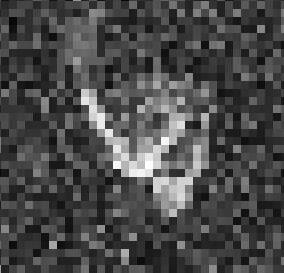Top Qs
Timeline
Chat
Perspective
(192642) 1999 RD32
Asteroid and suspected contact binary From Wikipedia, the free encyclopedia
Remove ads
(192642) 1999 RD32, provisional designation: 1999 RD32, is an asteroid and suspected contact binary on an eccentric orbit, classified as a large near-Earth object and potentially hazardous asteroid of the Apollo group, approximately 5 kilometers (3 miles) in diameter. It was discovered on 8 September 1999, at a magnitude of 18, by astronomers of the LINEAR program using its 1-meter telescope at the Lincoln Laboratory's Experimental Test Site near Socorro, New Mexico, United States.[3][2] The asteroid is likely of carbonaceous composition and has a rotation period of 17.08 hours.[4][a]
Remove ads
Description
Summarize
Perspective
1999 RD32 orbits the Sun at a distance of 0.6–4.7 AU once every 4 years and 4 months (1,571 days; semi-major axis of 2.64 AU). Its orbit has a high eccentricity of 0.77 and an inclination of 7° with respect to the ecliptic.[1]
The asteroid's observation arc begins with a precovery taken at Palomar Observatory in January 1995.[3] It is known that 1999 RD32 passed 0.0093 AU (1,390,000 km; 860,000 mi) from Earth on 27 August 1969.[10] During the 1969 close approach the asteroid reached about apparent magnitude 8.8.[11] The similarly sized 4179 Toutatis also reached that brightness in September 2004. It passed less than 0.007 AU (1,000,000 km; 650,000 mi) from asteroid 29 Amphitrite on 17 January 1939.[1]
Arecibo radar observations on 5–6 March 2012 showed that 1999 RD32 is approximately 5 kilometers (3 mi) in diameter[5] and has an estimated albedo of only 0.04.[5] Other sources calculate a smaller diameter of 1.63 kilometers based on a dated assumption, that the object is a stony rather than a carbonaceous asteroid.[4] The two visible lobes suggest that 1999 RD32 is a tight binary asteroid or contact binary.[5] About 10–15% of near-Earth asteroids larger than 200 meters are expected to be contact binary asteroids with two lobes in mutual contact.[12]
History of close approaches of large near-Earth objects since 1908 (A)
Remove ads
Numbering and naming
This minor planet was numbered by the Minor Planet Center on 13 November 2008.[13] As of 2018, it has not been named.[3]
Notes
- Lightcurve plot of (192642) 1999 RD32, Palmer Divide Observatory, B. D. Warner (2012): rotation period 17.08±0.03 hours with a brightness amplitude of 0.28±0.02 mag. Summary figures at the LCDB
References
External links
Wikiwand - on
Seamless Wikipedia browsing. On steroids.
Remove ads

